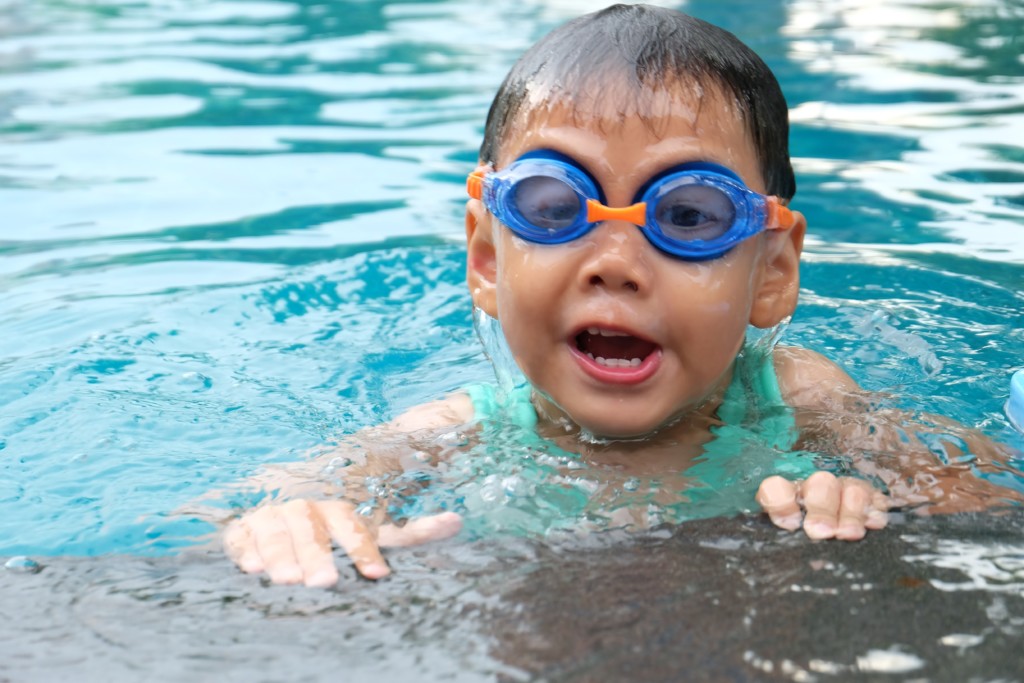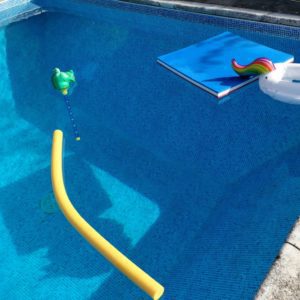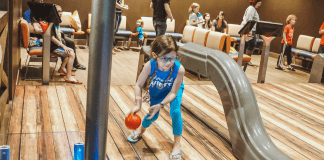Summer is coming. Cue thoughts of glaring sunbeams lovingly reflected off the glistening, pristine, clear pool water.
 Now, pause. If your kiddo cannot swim, this same image ought to trigger a whole different feeling of stress, puddle jumpers, you in the ice-cold water as you try to hold a splashing, wiggly, wet child above the water.
Now, pause. If your kiddo cannot swim, this same image ought to trigger a whole different feeling of stress, puddle jumpers, you in the ice-cold water as you try to hold a splashing, wiggly, wet child above the water.
There is an easier way. Teach your little tot to swim.
Having been in aquatics for most of my life, swimming has never been negotiable. It is what we do.
For child one, it came naturally. The other, I was pacing back and forth watching him in swim team warm-ups thinking he was going to drown. No exaggeration.
Some kids have a harder time learning to swim than others. With summer around the bend and future recreational activities involving water (birthday parties, kayaking, amusement parks, etc), it is worth the investment to enroll your kids into swim lessons.
Yet a common concern with parents is dropping the cash for things they can teach themselves but are unsure what skills they can actually teach. Below are some basics you can work on (note: this is not a replacement for formal lessons).
Step 1 in water safety – ask permission every time
From a young age, repetition is a much-utilized learning method. The more someone does an action, the more the body will want to do it without thought. Why would swimming be any different? Make your kiddo ask you every single time before they get in the water.
How quick would it be for a child to slip away to the pool while you turn to help another put on a lifejacket? It takes seconds. However, if somewhere inside of their mind they have been programmed they must ask your permission before entering the water, the hesitation will buy you the seconds to see if they start to Houdini on you.
Step 2 in water safety – no water wings
 Water wings, while common, are not safe. They take one sharp edge for the air to come out in a slow release and now your child’s safety is compromised. I know they are cheap – they are not worth it.
Water wings, while common, are not safe. They take one sharp edge for the air to come out in a slow release and now your child’s safety is compromised. I know they are cheap – they are not worth it.
Instead, opt for Puddle Jumpers or another US Coast Guard approved lifejacket. Many pools will even let you rent them if you do not want to spend the cash to purchase your own pair. Personally, I could not get my own kids to wear anything other than Puddle Jumpers, but they did so without complaint.
Step 3 in water safety – moving around the pool
What is the depth and how tall is your child? Is there a visible mark where your child will no longer be able to touch the bottom and keep her/his head above?
Some kiddos won’t be able to touch. It is important they know how to move safely around the pool and how to get in/out of the water (especially if stairs are not available). Teach your kids to Monkey Crawl if they cannot touch.
In our pool, there is a large 3 ft area and then descends quickly to 4 ft and deeper. The ladder starts the travel to 4 ft and so that was our visible marker. Our son could be in the “square” before the ladder on his own, but that was it.
Step 4 in water safety – teach them a back float
Easier said than done, I know. Lower yourself to your child’s level. This means you will be wet to your chin. Allow your child’s head to rest on your shoulder so they feel secure and put your hands under his/her armpits while walking backward. The water will naturally push up on their back allowing them to feel secure enough to relax.
Sing to them simultaneously. We always sang Twinkle, Twinkle Little Star and did the same thing in the bathtub, having them lay on their backs to wash out the shampoo. In time, this song instantly would relax them.
Eventually, you will be able to stand and look down into their eyes. Rest a toy on their bellies and tell them they are taking the toy for a ride. As they feel comfortable and seem to need less support, you can begin to let your hands drift or even waft up the water from below. Remind them to take a big breath (we have balloons in us) and to “starfish” their arms and legs. This part is a bit more advanced and may require lessons.
I am begging you, please do not remove your support without telling them and scare them by falling into the water. This will cause them to be distrustful later and make it harder to learn. Although many of us lived through the “throw in water and figure it out” method, we also rode in the front seats with no seatbelts at 5. Times change; methods improve.
A final tip for making lessons easier
A simple thing you can do is not shield their eyes when washing in the bath. Obviously, don’t let soapy water get in their eyes but with clean water, allow it to stream on their face. Sometimes this is a sensory issue but many times it is just getting used to the sensation. Marketing has sold us on the little visor that stops the water but this also makes them panic when they feel the water on their face in the pool.
And as always, water safety is a life skill. Find reputable lessons and sign up. They are worth the cost and freshen up before the next swim season.













